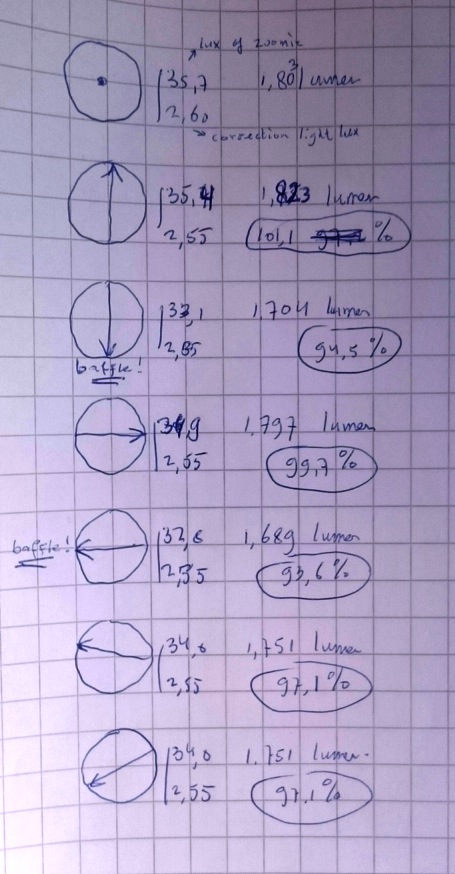We are planning on hooking up the sensor directly to David’s left eye, shine the light at the right one and a readout will come out the left ear. ![]()
That’s exactly how I tested the low end on my RRT01. ![]() That thing goes so low I can’t tell for sure if I’m seeing light or if it’s just my imagination… even after adjusting to the dark for hours and holding it directly to my eye.
That thing goes so low I can’t tell for sure if I’m seeing light or if it’s just my imagination… even after adjusting to the dark for hours and holding it directly to my eye.
Getting really excited now, can I borrow your David one of these days for a performance check?
This is the sphere that I use for all my emitter tests and flashlight output numbers, and here’s a check long overdue…
Recently I made a tiny zoomie (host=Ultrafire AT-007) with BLF-A6 driver and dedomed XP-G2 S3 3D. which makes a bright ultra-clean hotspot (40kcd on high), and today I realised that on the lowest modes, running on the single 7135 on the driver, it must have an extremely constant output. So it could be used to measure accurately the integrating properties of the sphere.
Here’s the experiment: with the light on level 3 (a very constant ~2lumen) and lens in spot modus I shined the spot straight down into the sphere and measured the output. This is the beam of an extreme thrower. Then did that again with the light at a very steep angle, measured in several directions, like this:

This is representative of the outer part of the spill of an extreme flooder.
I corrected all measurements for the altered reflectivity of the sphere caused by holding the flashlight in different positions.
Here are the results, the first measurement is the flashlight straight down into the sphere, what is how I normally measure a flashlight/ emitter. Then with the flashlight at the steepest possible angle, in various directions.

In position 3 and position 5 the beam was pointing straight at one of the baffles, which area makes out so little in the whole of directions that these a bit lower measurements can be neglected. Still a deviation of 7% with all light pointed on a baffle I find unexpectedly good.
So what can be seen is that there is a reading variety of maximal 3% compared to the position straight down, on average I estimate 2. Considering that the most extreme flooder will still have light in all directions instead of a ring going to the side, I estimate the difference between extreme thrower and extreme flooder just 1.
I am happy with the result, it implies i.e. that I’m confident that the djozz-lumen is virtually the same both for all flashlights and for all bare emitters, something I still was a bit worried about.
Excellent work there! PM me for my shipping address… ![]()
:laughing: :laughing: :laughing: :laughing: :laughing:
Excellent work there! PM me for my shipping address…
:laughing: :laughing: :laughing: :laughing: :laughing:
:person_facepalming: ![]()
What Steve? Did I beat ya to it? ![]()
My girlfriend would still love to get rid of that bulky thing covered in hobby-stuff in the livingroom (where my corner-o-junk is). I will not get you guys in touch with her!
You need a garage djozz. They call them man caves here. ![]()
You need a garage djozz. They call them man caves here.
Yes I’d love one, but our modest 2-floors-up apartment did not come with one and the average garage within the ring road of Amsterdam goes for €20,000 ![]()
Take nothing away from you djozz. You do invaluable work with what you have. And very smart to boot. ![]()